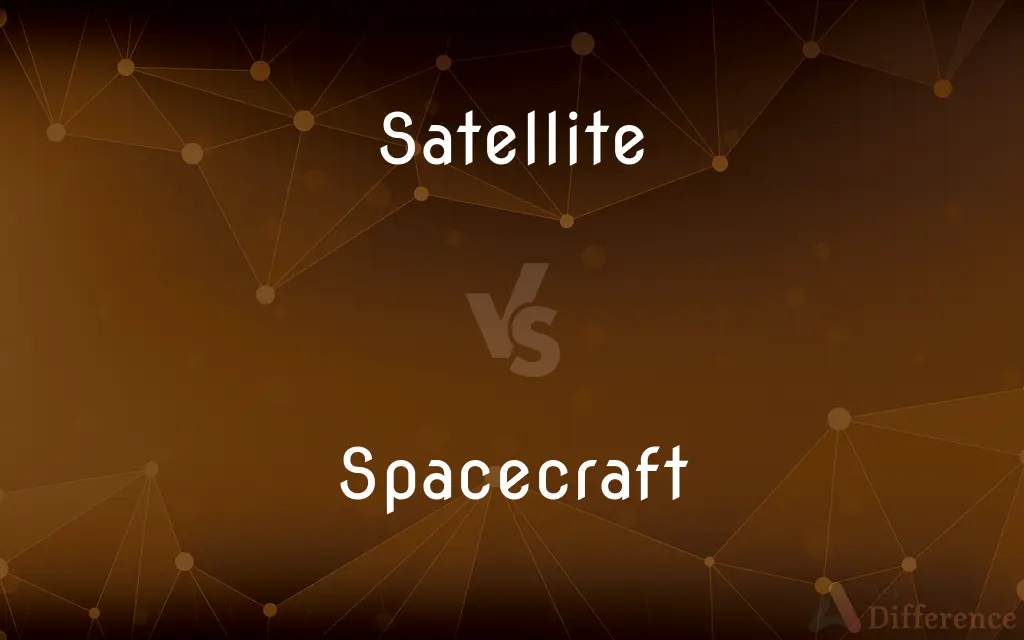Satellite vs. Spacecraft — What's the Difference?
By Fiza Rafique & Maham Liaqat — Updated on March 14, 2024
A satellite orbits a body in space, while a spacecraft is designed for space travel.

Difference Between Satellite and Spacecraft
Table of Contents
ADVERTISEMENT
Key Differences
Satellites are objects that orbit planets, moons, or other celestial bodies, either naturally, like moons, or artificially, like communication satellites. Spacecraft, on the other hand, are vehicles engineered for space exploration, travel, or research, and can include manned or unmanned vehicles such as shuttles, probes, and rovers.
While all artificial satellites are a type of spacecraft designed specifically for orbiting, not all spacecraft are satellites. For example, a spacecraft intended for landing on Mars or returning to Earth is not considered a satellite. This distinction highlights the specific function and trajectory of satellites compared to the broader capabilities of spacecraft.
Satellites are often used for communication, weather monitoring, Earth observation, and scientific research while remaining in orbit around a celestial body. Spacecraft can carry out a wider range of missions, including human spaceflight, planetary exploration, and even carrying satellites into space to deploy them into orbit.
The design and technology of satellites focus on longevity and stability in a fixed orbit, with many equipped to stay in space for years or even decades. Spacecraft designed for missions beyond orbiting may have more complex systems for navigation, landing, and return to Earth, or for deep space communication.
Artificial satellites can be geostationary, maintaining a position relative to the Earth, or in various other orbits depending on their mission. Spacecraft, especially those designed for exploration, often have trajectories that take them far from Earth, to other planets, or into deep space, requiring different propulsion and navigation technologies.
ADVERTISEMENT
Comparison Chart
Primary Function
Orbits a celestial body
Designed for space travel and exploration
Types
Natural (moons) and artificial (communication, observation satellites)
Manned (shuttles), unmanned (probes, rovers)
Purpose
Communication, weather monitoring, Earth observation
Human spaceflight, planetary exploration
Design Focus
Longevity and stability in orbit
Navigation, landing, deep space communication
Trajectory
Fixed orbit around Earth or other bodies
Varied, including orbit, landing on celestial bodies, deep space
Compare with Definitions
Satellite
Orbits celestial bodies.
The satellite circled Earth in a geostationary orbit.
Spacecraft
Designed for space exploration.
The spacecraft was launched to explore Mars.
Satellite
Earth observation.
Weather satellites provide crucial data for forecasting.
Spacecraft
Includes rovers.
Rovers have been used to explore the Martian surface.
Satellite
Geostationary orbit.
Some satellites maintain a fixed position relative to Earth's surface.
Spacecraft
Complex missions.
Deep-space probes are sent to study distant celestial phenomena.
Satellite
Used for communication.
Communication satellites facilitate global TV broadcasts.
Spacecraft
Varied trajectories.
Spacecraft can have trajectories that take them to other planets or into deep space.
Satellite
Longevity in space.
Many satellites are designed to operate for over a decade.
Spacecraft
Can carry humans.
The space shuttle carried astronauts to the International Space Station.
Satellite
In the context of spaceflight, a satellite is an object that has been intentionally placed into orbit. These objects are called artificial satellites to distinguish them from natural satellites such as Earth's Moon.
Spacecraft
A spacecraft is a vehicle or machine designed to fly in outer space. A type of artificial satellite, spacecraft are used for a variety of purposes, including communications, Earth observation, meteorology, navigation, space colonization, planetary exploration, and transportation of humans and cargo.
Satellite
An object launched to orbit Earth or another celestial body, as a device for reflecting or relaying radio signals or for capturing images.
Spacecraft
A vehicle designed to be launched into space. Also called spaceship.
Satellite
(Astronomy) A celestial body, such as a moon, planet, comet, or other solar system body, that orbits a larger body.
Spacecraft
A vehicle that travels through space.
Satellite
A small unit in a system or organization that is managed or controlled by a larger, often centrally located unit.
Spacecraft
A vehicle capable of travelling in or into outer space; at present, all such vehicles are powered by rocket engine.
Satellite
A nation dominated politically and economically by another nation.
Spacecraft
A craft capable of traveling in outer space; technically, a satellite around the sun
Satellite
An urban or suburban community located near a big city.
Satellite
One who attends a powerful dignitary; a subordinate.
Satellite
A subservient follower; a sycophant.
Satellite
(Genetics) A short segment of a chromosome separated from the rest by a constriction, typically associated with the formation of a nucleolus.
Satellite
(Microbiology) A colony of microorganisms whose growth in culture medium is enhanced by certain substances produced by another colony in its proximity.
Satellite
Of, relating to, or being a satellite.
Satellite
Of or relating to the transmission of electromagnetic signals by communications satellite
Satellite broadcasting.
Satellite phone.
Satellite
A moon or other smaller body orbiting a larger one.
The Moon is a natural satellite of the Earth.
A spent upper stage is a derelict satellite.
Satellite
A man-made apparatus designed to be placed in orbit around a celestial body, generally to relay information, data etc. to Earth.
Many telecommunication satellites orbit at 36000km above the equator.
Satellite
A country, state, office, building etc. which is under the jurisdiction, influence, or domination of another body.
Satellite
An attendant on an important person; a member of someone's retinue, often in a somewhat derogatory sense; a henchman.
Satellite
Satellite TV; reception of television broadcasts via services that utilize man-made satellite technology.
Do you have satellite at your house?
Satellite
(grammar) A grammatical construct that takes various forms and may encode a path of movement, a change of state, or the grammatical aspect. Examples: "a bird flew past"; "she turned on the light".
Satellite
To transmit by satellite.
Satellite
An attendant attached to a prince or other powerful person; hence, an obsequious dependent.
Satellite
A secondary planet which revolves about another planet; as, the moon is a satellite of the earth. See Solar system, under Solar.
Satellite
Situated near; accompanying; as, the satellite veins, those which accompany the arteries.
Satellite
Man-made equipment that orbits around the earth or the moon
Satellite
A person who follows or serves another
Satellite
Any celestial body orbiting around a planet or star
Satellite
Broadcast or disseminate via satellite
Satellite
Surrounding and dominated by a central authority or power;
A city and its satellite communities
Common Curiosities
What defines a satellite?
A satellite is defined by its orbit around a planet or moon, either as a natural body like a moon or an artificial object placed by humans.
Can a spacecraft become a satellite?
Yes, a spacecraft can become a satellite if it is placed into orbit around a celestial body and remains there.
What are the main uses of satellites?
Satellites are mainly used for communication, Earth observation, navigation, and scientific research.
Are all satellites man-made?
No, natural satellites like moons are not man-made, but artificial satellites are.
How do satellites stay in orbit?
Satellites stay in orbit due to the balance between their velocity and the gravitational pull of the body they orbit.
What technologies are crucial for spacecraft?
Navigation, propulsion, life support (for manned missions), and communication technologies are crucial for spacecraft.
What kind of missions do spacecraft undertake?
Spacecraft missions can include human spaceflight, exploration of other planets, scientific research, and deploying satellites.
What is a spacecraft?
A spacecraft is a vehicle designed to operate in outer space, which can include carrying humans, exploration, or deploying satellites.
Do satellites return to Earth?
Most satellites are not designed to return to Earth; they remain in space until they cease functioning or are deorbited.
How do spacecraft navigate in space?
Spacecraft use a combination of propulsion systems, celestial navigation, and guidance from mission control on Earth.
Share Your Discovery

Previous Comparison
Stockade vs. Palisade
Next Comparison
Quick vs. SpeedyAuthor Spotlight
Written by
Fiza RafiqueFiza Rafique is a skilled content writer at AskDifference.com, where she meticulously refines and enhances written pieces. Drawing from her vast editorial expertise, Fiza ensures clarity, accuracy, and precision in every article. Passionate about language, she continually seeks to elevate the quality of content for readers worldwide.
Co-written by
Maham Liaqat














































